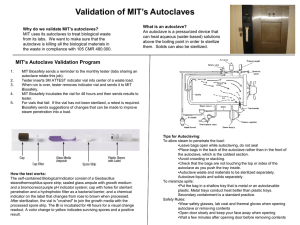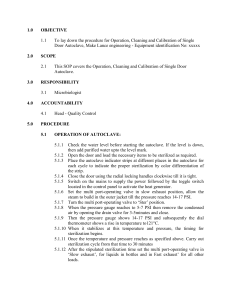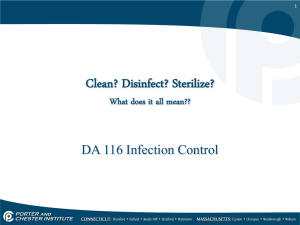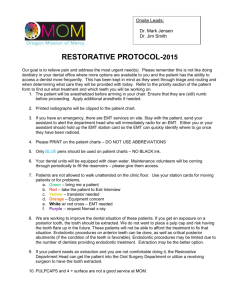Sterilization and Disinfection
advertisement
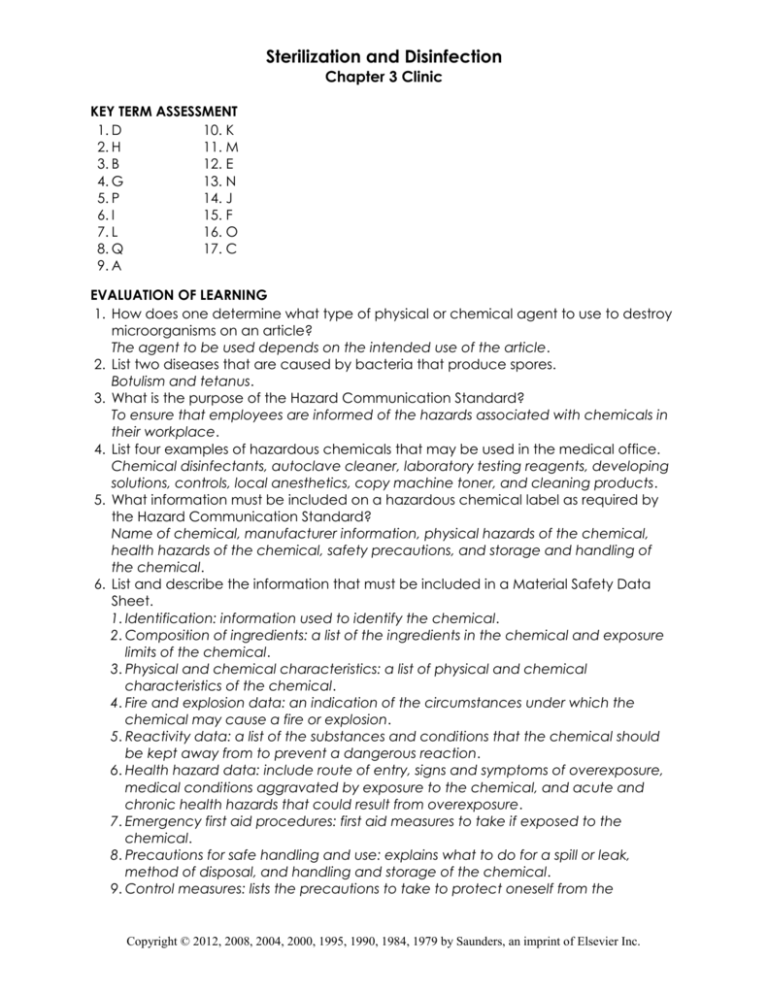
Sterilization and Disinfection Chapter 3 Clinic KEY TERM ASSESSMENT 1. D 10. K 2. H 11. M 3. B 12. E 4. G 13. N 5. P 14. J 6. I 15. F 7. L 16. O 8. Q 17. C 9. A EVALUATION OF LEARNING 1. How does one determine what type of physical or chemical agent to use to destroy microorganisms on an article? The agent to be used depends on the intended use of the article. 2. List two diseases that are caused by bacteria that produce spores. Botulism and tetanus. 3. What is the purpose of the Hazard Communication Standard? To ensure that employees are informed of the hazards associated with chemicals in their workplace. 4. List four examples of hazardous chemicals that may be used in the medical office. Chemical disinfectants, autoclave cleaner, laboratory testing reagents, developing solutions, controls, local anesthetics, copy machine toner, and cleaning products. 5. What information must be included on a hazardous chemical label as required by the Hazard Communication Standard? Name of chemical, manufacturer information, physical hazards of the chemical, health hazards of the chemical, safety precautions, and storage and handling of the chemical. 6. List and describe the information that must be included in a Material Safety Data Sheet. 1. Identification: information used to identify the chemical. 2. Composition of ingredients: a list of the ingredients in the chemical and exposure limits of the chemical. 3. Physical and chemical characteristics: a list of physical and chemical characteristics of the chemical. 4. Fire and explosion data: an indication of the circumstances under which the chemical may cause a fire or explosion. 5. Reactivity data: a list of the substances and conditions that the chemical should be kept away from to prevent a dangerous reaction. 6. Health hazard data: include route of entry, signs and symptoms of overexposure, medical conditions aggravated by exposure to the chemical, and acute and chronic health hazards that could result from overexposure. 7. Emergency first aid procedures: first aid measures to take if exposed to the chemical. 8. Precautions for safe handling and use: explains what to do for a spill or leak, method of disposal, and handling and storage of the chemical. 9. Control measures: lists the precautions to take to protect oneself from the Copyright © 2012, 2008, 2004, 2000, 1995, 1990, 1984, 1979 by Saunders, an imprint of Elsevier Inc. Chapter 03: Sterilization and Disinfection 3-2 chemical. 10. What is the purpose of sanitizing an article? To remove organic matter from an article and to reduce the number of microorganisms to a safe level. 11. What is the advantage of using the ultrasound method to clean instruments? It offers a safety advantage in that the instruments do not have to be handled during the cleaning process, which decreases the incidence of an accidental puncture or cut from a sharp instrument. 12. Why should gloves be worn during the sanitization procedure? To protect the MA from bloodborne pathogens and OPIM and to protect the hands from the irritating effects of chemical agents and accidental punctures or cuts from sharp instruments. 13. What is the definition of high-level disinfection? 14. List one example of an item that requires high-level disinfection. List one example of a high-level disinfectant. Item: flexible fiberoptic sigmoidoscope. Disinfectant: glutaraldehyde. 15. List two examples of items that can be disinfected through intermediate-level disinfection. List one example of an intermediate-level disinfectant. Items: stethoscopes, blood pressure cuffs, tuning forks, percussion hammers, and crutches. Disinfectants: ethyl alcohol and isopropyl alcohol. 16. List two examples of items that are disinfected by low-level disinfection. Examining tables, laboratory countertops, and walls. 17. What disinfectant does OSHA recommend for the decontamination of blood spills? A 10% solution of household bleach in water. 18. Why is it important to remove all organic matter from an article before it is disinfected? Organic matter prevents the chemical disinfectant from reaching the surface of the article to kill microorganisms. 19. Explain the difference between the shelf life and use life of a chemical disinfectant. Shelf life is the length of time a chemical disinfectant may be stored before use and still retain its effectiveness. Use life is the period of time a disinfecting solution is effective after it has been activated. 20. What is the purpose of the pressure used in the autoclaving process? It functions to attain a higher temperature than could be reached by the steam from boiling water alone. 21. Why is it important that all air be removed from the autoclave during the sterilization process? When air is present, the temperature in the autoclave is reduced, and a temperature that is adequate for sterilization is not reached. 22. What are the most common temperature and pressure used to sterilize materials with the autoclave? Temperature: 250° F. Pressure: 15 psi. 23. What information does the CDC recommend be recorded in an autoclave log regarding each cycle? Date and time of the cycle, description of the load, exposure time, exposure temperature, results of the sterilization indicator, and initials of the operator. 24. What is the function of a sterilization indicator? To determine the effectiveness of the sterilization procedure and to check against Copyright © 2012, 2008, 2004, 2000, 1995, 1990, 1984, 1979 by Saunders, an imprint of Elsevier Inc. Chapter 03: Sterilization and Disinfection 3-3 improper wrapping of articles, improper loading of the autoclave, or faulty operation of the autoclave. 25. What is the purpose of wrapping articles to be autoclaved? To protect them from recontamination during handling and storage. 26. List two properties of a good wrapper for use in autoclaving. A substance that is not affected by the sterilization process and a substance that allows steam to penetrate while preventing contaminants from entering during handling and storage. 27. List three examples of wrapping material used for the autoclave and identify an advantage of each type. Sterilization paper: disposable and inexpensive. Sterilization pouches: provide good visibility of the contents; usually include a sterilization indicator. Muslin: economical because it can be reused; lies flat when opened. 28. Why is more time needed to autoclave a large minor office surgery pack? It takes longer for the steam to penetrate to the center of the pack. 29. What is event-related sterility? A sterile pack is considered sterile unless an event occurs that interferes with the sterility of the article, such as crushing, compressing, or dropping the pack. 30. Describe the care an autoclave should receive on a daily basis. Wipe the outside of the autoclave with a damp cloth and a mild detergent; wipe the interior of the autoclave, trays, and rubber gasket with a damp cloth; and inspect the rubber door gasket for possible damage that could prevent a good seal. 31. Why is a longer exposure period needed to ensure sterilization when using the dryheat oven? Microorganisms are more resistant to dry heat than moist heat, and dry heat penetrates more slowly and unevenly than moist heat. 32. What effect does moist heat have on instruments with sharp cutting edges? It dulls their sharp points or edges. 33. How does the medical manufacturing industry use ethylene oxide gas sterilization? For producing prepackaged, presterilized disposable items, such as syringes, sutures, catheters, and surgical packs. 34. What guidelines must be followed when using cold sterilization? Only chemicals designated as sterilants by the EPA can be used for sterilizing articles; the items to be sterilized must be submerged in the chemical for 6 to 24 hours; each time a new instrument is added to the container, the clock must be restarted for the entire amount of time; cold sterilization should be used only when steam, gas, or a dry heat oven is not indicated or is unavailable. CRITICAL THINKING ACTIVITIES A. Material Safety Data Sheet Refer to the Material Safety Data Sheet (MSDS) (see Fig. 3-2 in your textbook), and answer the following questions. 1. When was this MSDS last revised? 8/8/2010. 2. Is glutaraldehyde soluble in water? Yes. 3. Describe the appearance and odor of glutaraldehyde. Bluish green liquid, sharp odor. Copyright © 2012, 2008, 2004, 2000, 1995, 1990, 1984, 1979 by Saunders, an imprint of Elsevier Inc. Chapter 03: Sterilization and Disinfection 3-4 4. 5. 6. 7. What is the pH of glutaraldehyde? 7.5 to 8.5. Is glutaraldehyde flammable? No. Is glutaraldehyde stable? Yes. What conditions should be avoided with glutaraldehyde? Direct sunlight, temperatures greater than 104° F (40° C). 8. How can glutaraldehyde enter the body? Through the skin and eyes and by being inhaled or ingested. 9. What symptoms occur if glutaraldehyde does the following? a. Comes in contact with the skin Moderate irritation. b. Is splashed into the eyes Serious eye irritant; may cause irreversible damage, which could permanently impair vision. c. Is inhaled Vapors may be severely irritating and cause stinging sensation in the eyes, nose, throat, and lungs. d. Is ingested May cause irritation or chemical burns of the mouth, throat, esophagus, and stomach; may cause vomiting, epigastric distress, diarrhea, dizziness, faintness, mental confusion, and general systemic illness. 10. What preexisting conditions can an individual possess that can be aggravated by glutaraldehyde? Dermatitis and asthma. 11. Does glutaraldehyde cause cancer? No. 12. What are the emergency and first aid procedures for glutaraldehyde for the following? a. Skin Wash skin with soap and water for 15 minutes; if skin redness or irritation persists, seek medical attention. b. Eyes Immediately flush with water for 15 minutes; seek medical attention. c. Inhalation Remove to fresh air immediately; if irritation persists, seek medical attention. d. Ingestion Do not induce vomiting; call a physician or poison control center immediately. 13. What should be done if glutaraldehyde is spilled? Ventilate area; wear protective gloves and eye gear; wipe with sponge, mop, or towel; flush with large quantities of water; and collect liquid and discard it. 14. What is the disposal method for glutaraldehyde? Container must be triple-rinsed and disposed of in accordance with federal, state, or local regulations. Used solution should be flushed thoroughly with water into sewage disposal system in accordance with federal, state, or local regulations. 15. How should glutaraldehyde be stored? Store in a cool, dry place away from direct sunlight or sources of intense heat; keep container tightly closed when not in use. 16. What type of ventilation is needed when working with glutaraldehyde? Ensure adequate ventilation to maintain recommended exposed limit. 17. What skin and eye protection should be taken with glutaraldehyde? Wear chemical-resistant protective gloves—butyl rubber, nitrile rubber, polyethylene, or double-gloved latex; wear safety goggles or safety glasses. B. Obtaining a Material Safety Data Sheet Obtain an MSDS for one of the hazardous chemicals listed below, and answer the following questions. To locate an MSDS on the Internet, enter the name of the chemical into a search engine with the abbreviation “MSDS” (Example: Cidex MSDS). • Cidex Copyright © 2012, 2008, 2004, 2000, 1995, 1990, 1984, 1979 by Saunders, an imprint of Elsevier Inc. Chapter 03: Sterilization and Disinfection 3-5 • MetriCide • Cidex OPA • CaviCide • MadaCide • Wavicide • Biozide • Sporox II • Vesphene • Envirocide • Clorox bleach 1. What is the chemical name of this hazardous chemical? 2. What is the trade or brand name of this chemical? 3. Who manufactures this chemical? 4. What number would you call if an emergency occurred with this chemical? 5. What type of symptoms occur if this chemical does the following? a. Comes in contact with the skin b. Is splashed into the eyes c. Is inhaled d. Is ingested 6. What are the emergency and first aid procedures for this chemical? 7. What should be done if this chemical is spilled? 8. What is the disposal method for this chemical? 9. How should this chemical be stored? 10. What type of protection should be taken when working with this chemical? Answers vary based on the MSDS selected by each student. C. Sanitization For each of the following situations involving sanitization, write C if the technique is correct and I if the technique is incorrect. If the situation is correct, state the principle underlying the technique. If the situation is incorrect, explain what might happen if the technique was performed in the incorrect manner. 1. A contaminated surgical instrument is left in the examination room. I: May cause the transfer of disease from pathogens that the instrument may contain. 2. The medical assistant does not wear gloves when sanitizing surgical instruments. I: The MA’s hands would not be protected from bloodborne pathogens and other potentially infectious materials or the irritating effects of chemical agents and accidental punctures or cuts from sharp instruments. 3. The medical assistant piles instruments in a heap while preparing them for sanitization. I: The instruments may become entangled and may be damaged when separated. 4. The medical assistant forgets to read the material safety data sheet before decontaminating some surgical instruments in Cidex. I: When working with Cidex, the MA would not have knowledge of the hazards of Cidex or the measures to take to avoid illness and injury when handling it. 5. The medical assistant uses laundry detergent to sanitize surgical instruments. I: Laundry detergent is not low-sudsing and may not have the proper pH for sanitizing instruments, which could cause stains on the instruments. Copyright © 2012, 2008, 2004, 2000, 1995, 1990, 1984, 1979 by Saunders, an imprint of Elsevier Inc. Chapter 03: Sterilization and Disinfection 3-6 6. Dried blood is not completely cleansed from hemostatic forceps before they are sterilized in the autoclave. I: Blood acts as a physical barrier during sterilization, preventing steam from reaching the surface of the article to kill microorganisms. 7. The medical assistant checks all instruments for proper working condition before sterilizing them. C: Instruments cannot be checked for proper working condition after they are sterile. 8. The medical assistant lubricates hemostatic forceps with a steampenetrable lubricant before sterilizing them. C: A lubricant that can be penetrated by steam must be used; otherwise the lubricant would build up on the instrument, affecting its working condition; lubricating an instrument makes it function better and last longer. D. Storage of a Chemical Disinfectant You have just received a 0.5-gallon container of Cidex Plus. You look at the label on the container and notice the following: • Expiration date: 8/7/12 • Use life: 28 days • Reuse life: 28 days Based on this information, answer the following questions. 1. If the Cidex Plus is left unopened on the shelf, when would it expire and need to be discarded? 8/7/2012. 2. You open and activate the Cidex Plus on 9/1/11. What date should you write on the container? 9/29/2011. 3. You next fill a disinfectant container with the Cidex Plus and disinfect some articles in it. On what date would the Cidex Plus be unusable and need to be disposed? 9/29/2011. 4. On what date would you need to discard the rest of the container of Cidex Plus if it is not used? 9/29/2011. E. Sterilization For each of the following situations involving sterilization, write C if the technique is correct and I if the technique is incorrect. If the situation is correct, state the principle underlying the technique. If the situation is incorrect, explain what might happen if the technique were performed in the incorrect manner. 1. The medical assistant opens a hemostat before placing it in a sterilization pouch. C: This allows steam to penetrate all parts of the instrument. 2. Tap water is used to fill the water reservoir of the autoclave. I: Tap water causes corrosion of the stainless steel chamber of the autoclave. 3. When loading the autoclave, the medical assistant places glass jars in an upright position. I: This may cause air to become trapped in them, and they would not be properly sterilized. 4. The medical assistant places four sterilization pouches on top of each other in the autoclave. I: Placing pouches on top of each other results in inadequate steam penetration. 5. The medical assistant places small packs to be sterilized approximately 1 to 3 inches apart in the autoclave. C: Placing small packs 1 to 3 inches apart allows for adequate steam penetration. 6. Spore strips are placed in the autoclave where steam will penetrate them most easily. I: The strips should be placed in areas of the autoclave that are least Copyright © 2012, 2008, 2004, 2000, 1995, 1990, 1984, 1979 by Saunders, an imprint of Elsevier Inc. Chapter 03: Sterilization and Disinfection 3-7 accessible to steam penetration. 7. The medical assistant begins timing the load in the autoclave after the proper temperature of 250° F has been reached. C: The load should not be timed until the gauge reaches the desired temperature to ensure sterilization. 8. The medical assistant removes the load from the autoclave while it is still wet. I: If the articles are wet, microorganisms can move very quickly through the moisture on the wrap and contaminate the sterile article inside. 9. The medical assistant notices a tear in one of the wrappers while removing articles from the autoclave. He or she rewraps and resterilizes the article. C: A torn pack is no longer sterile and must not be used. 10. The medical assistant notices that a sterilized wrapped article stored on the storage shelf has opened up. He or she retapes the pack and places it back on the storage shelf. I: A wrapped sterilized article that opens up is considered contaminated and must be rewrapped and resterilized. APPLY YOUR KNOWLEDGE Choose the best answer to each of the following questions. 1. Kara Van Dyke, CMA (AAMA), is getting ready to sanitize surgical instruments that were used to perform a minor office surgery. Kara performs all of the following steps except A. Applies clean disposable gloves B. Applies heavy-duty utility gloves C. Separates sharp and delicate instruments from other instruments D. Rinses the instruments under a stream of hot water 2. Kara prepares to decontaminate the instruments using Cidex Plus chemical disinfectant. The purpose of decontaminating instruments is to A. Prevent organic material from drying on the instruments B. Remove pathogenic microorganisms from the instruments C. Remove stains from the instruments D. Lubricate the instruments 3. Kara needs to know what personal protective equipment she should use when working with Cidex Plus. Which of the following would provide her with this information? A. The MSDS for Cidex Plus B. The label on the container of Cidex Plus C. Both the MSDS and the container label for Cidex Plus D. Her driver’s license 4. Kara performs the decontamination process. She performs all of the following steps except A. Checks the expiration date on the label of the chemical disinfectant B. Completely submerges the instruments in the chemical disinfectant C. Scrubs the instruments with a nylon brush D. Disinfects the instruments for 10 minutes 5.After the instruments have been decontaminated, Kara prepares to clean them using a commercial instrument cleaner. Kara checks the label of the instrument cleaner to ensure A. It is low sudsing. B. It has an acidic pH. Copyright © 2012, 2008, 2004, 2000, 1995, 1990, 1984, 1979 by Saunders, an imprint of Elsevier Inc. Chapter 03: Sterilization and Disinfection 3-8 C. It destroys bacterial spores. D. Four of five dentists recommend this cleaner. 6. Kara prepares the cleaning solution and places the instruments in the basin that contains the solution. Which of the following does Kara perform to complete the sanitization procedure? A. Cleanses the surface of each instrument with a nylon brush B. Rinses each instrument for 20 to 30 seconds C. Dries the instruments D. Checks the working order of each instrument E. All of the above 7. Kara is preparing to autoclave the surgical instruments that she sanitized. She wraps the instruments in sterilization paper before placing them in the autoclave. What is the purpose of wrapping articles that are to be sterilized? A. To permit better steam penetration during autoclaving B. To protect the articles from recontamination after autoclaving C. So that they can be given as Christmas gifts D. To protect the instruments from damage 8. Kara is getting ready to autoclave the wrapped packs of surgical instruments. Which of the following would represent an error in technique during the autoclaving process? A. Filling the water reserve with tap water B. Loading the autoclave by positioning the packs 1 to 3 inches apart C. Setting the timer when the temperature gauge reaches 250° F D. Ensuring that the sterilized packs are dry before removing them from the autoclave 9. When Kara removes a pack from the autoclave, she notices the autoclave tape has changed color. She realizes that this indicates that A. The autoclave is functioning properly. B. The pack has been exposed to heat. C. The pack has been exposed to a temperature of 250° F for 15 minutes. D. The pack needs to be rewrapped and run through the autoclave again. 10. Kara properly stores the sterilized packs. Kara performs all of the following steps except A. Handles the packs carefully and as little as possible B. Rewraps and re-sterilizes a pack that is torn C. Places the packs in a clean, dustproof area D. Places the sterilized packs in front of previously sterilized packs VIDEO EVALUATION FOR CHAPTER 3: STERILIZATION AND DISINFECTION Directions: a. Watch the indicated videos. b. Mark each true statement with a T and each false statement with an F. For each false statement, change the wording of the question so that it becomes a true statement. Video: Procedure 3-1: Sanitization of Instruments ____T___ 1. Before surgical instruments can be sterilized in the autoclave, they must first be sanitized. Copyright © 2012, 2008, 2004, 2000, 1995, 1990, 1984, 1979 by Saunders, an imprint of Elsevier Inc. Chapter 03: Sterilization and Disinfection 3-9 ____F___ 2. Sanitization involves a series of steps designed to remove all microorganisms and spores from an article. ____T___ 3. An MSDS provides information regarding a chemical, its hazards, and measures to take to prevent injury and illness when handling the chemical. ____F___ 4. After removing used instruments from an examining room, immediately rinse them thoroughly under hot running water to remove organic material. ____T___ 5. Instruments undergoing sanitization should be decontaminated by disinfecting them in an EPA-approved chemical disinfectant. ____F___ 6. The instrument disinfectant container should be labeled with the name of the disinfectant and today’s date. ____T___ 7. An instrument cleaning agent that has expired loses its potency and should not be used. ____F___ 8. A wire brush should be used to clean the surface of each instrument. ____T___ 9. After cleaning each instrument, rinse it thoroughly with warm water. ____T___ 10. If the instrument is not completely dry following sanitization, stains may occur on the instrument. ____F___ 11. An instrument should be rinsed after a lubricant has been applied to it. ____T___ 12. The manufacturer’s instructions specify how to dispose of the instrument cleaning solution. Video: Procedures 3-3 and 3-4: Wrapping Instruments ____T___ 1. The purpose of wrapping an instrument is to protect it from recontamination during handling and storage. ____T___ 2. If a minor office surgery setup is being wrapped, a double layer of sterilization paper is often used. ____F___ 3. The wrapping material consists of a substance that prevents steam from reaching the instrument during the sterilization process. ____T___ 4. If the sterilization strips are outdated, they may provide inaccurate results. ____T___ 5. An instrument should be placed in the center of the sterilization wrapping paper, with the longest part of the instrument pointing toward the two side corners. ____F___ 6. If an instrument has a movable joint, it should be placed in a slightly closed position when wrapping an instrument. ____T___ 7. A sterilization indicator strip is placed in the center of the pack next to the instrument. ____T___ 8. The pack should be marked with the date of the sterilization and your initials. ____T___ 9. If a sterilization indicator does not change appropriately, the item is not sterile and must not be used. ____F___ 10. Autoclave tape turns from white to black, which indicates that the autoclaved item is sterile. Video: Procedure 3-5: Sterilizing Articles in the Autoclave ____T___ 1. Sterilization of articles in the autoclave destroys all microorganisms and spores. ____F___ 2. The autoclave is typically operated at 15 pounds of pressure at a temperature of 212° F. Copyright © 2012, 2008, 2004, 2000, 1995, 1990, 1984, 1979 by Saunders, an imprint of Elsevier Inc. Chapter 03: Sterilization and Disinfection 3-10 ____F___ 3. A surgical instrument requires a longer sterilizing time than a minor office surgery pack. ____T___ 4. Before an article can be sterilized in the autoclave, it must first be sanitized. ____T___ 5. Water contained in the water reservoir of the autoclave is converted to steam during the sterilization process. ____F___ 6. Warm tap water must be used in the autoclave because it prevents corrosion of the stainless-steel chamber of the autoclave. ____T___ 7. Small packs should be placed 1 to 3 inches apart, and large packs should be placed 2 to 4 inches apart in the autoclave to provide for adequate steam penetration. ____F___ 8. Pouches should be placed on an autoclave tray with the plastic side up and the paper side facing down. ____F___ 9. An autoclave load is dried by cracking open the door approximately 6 inches. ____T___ 10. The autoclave packs must dry fully; otherwise microorganisms can move through the moisture on a wet wrap and contaminate the sterile article inside. ____T___ 11. If an autoclaved pack shows any damage, such as holes or tears, the article should be rewrapped and resterilized. ____F___ 12. Store the packs in a clean, dustproof area with the most recently sterilized packs placed in front of previously sterilized packs. ____F___ 13. Daily care of the autoclave includes scrubbing the interior of the autoclave and the trays with scouring powder. ____T___ 14. The rubber door gasket should be inspected for damage that could prevent a good seal. Copyright © 2012, 2008, 2004, 2000, 1995, 1990, 1984, 1979 by Saunders, an imprint of Elsevier Inc.





